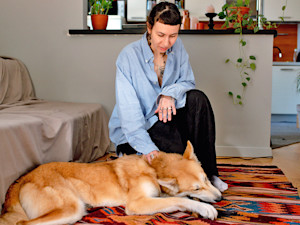Why Does My Dog Have Black Spots on Their Skin?
Is that normal?

Share Article
I noticed tiny black spots on my dog’s skin a few weeks ago, and now they seem to be growing. It started off with a little darkening of color on my dog’s belly, then spread from there. Now I’m noticing that the skin underneath my dog’s hair is black as well. I’m pretty sure it wasn’t like this before, what can cause black spots on dog’s skin?
Questions like this are common from pet parents who notice a sudden change in their dog’s skin color. Dogs can have skin color changes for many reasons. For instance, a dog with black spots on their skin, itchy feet and ears, and a change in their body odor may have a superficial skin infection. While most causes of darkening of a dog’s skin are relatively benign and can be treated with topical therapy, some can be quite serious. It’s always a good idea to see your veterinarian if your dog has any sudden changes in the appearance of their skin.
Reasons for black spots on a dog’s skin
The reasons for black areas to appear on a dog’s skin can be systemic or local. The most common causes for dark spots to appear are related to primary skin diseases. With almost any insult to the skin, dogs can develop something called post-inflammatory hyperpigmentation.

Basically, extra melanin (the pigment that produces darkening of skin) is produced around any inflamed areas of skin. Extra melanin is produced in inflamed skin — the longer skin remains inflamed, the more melanin builds up, leading to darker coloration. It also takes some time to go away after inflammation has resolved, meaning some black spots on a dog’s skin could persist for weeks after the initial problem is resolved.
Figuring out what’s causing the pigmentation can be a challenge though. In my experience, testing is usually needed to get to the bottom of most occurrences of darkened skin on dogs. These tests can include
Checking for surface parasites like fleas or mites
Skin cytology to look at the cells, yeast, and bacteria on the surface of the skin
Skin scraping to check for mange
Biopsy to examine the structural makeup of the skin and look for cancer cells
Bloodwork to diagnose metabolic disorders
Conditions that can be found or ruled out with these tests include:
Skin infections
Dog-skin infections can occur secondary to overgrowth of bacteria or yeast. Many of these microbes are a normal part of a dog's skin flora. They may grow out of control secondary to other problems like allergies, stress, or parasites. Skin infections may only result in symptoms like itchiness and redness, or they may appear as crusty spots on dogs’ skin. Many skin infections can be treated with topical therapies like medicated wipes or shampoos available from your veterinarian.
Parasites
Parasites, like fleas, can cause irritation to skin that results in darkening of the skin. This is especially true of chronic infestations. You may notice color changes are most significant in areas where fleas tend to congregate, such as the base of the tail, the belly, or the neck. Serious infestations are usually obvious, but a careful check with a flea comb can help to find hidden fleas in thick-haired dogs.
Allergies
Most chronic skin issues in dogs are due to allergies. Dogs can be allergic to food, pollen, mites, or basically anything they come into contact with. Allergies cause skin inflammation and can result in black areas on a dog’s skin. The belly, feet, and genitals are some of the most common areas for color changes.
Mange
Both demodectic (demodex) and sarcoptic mange (scabies) cause severe irritation to dogs’ skin and can result in hair loss, blackened areas of skin, and skin lesions. Mange is especially common in puppies and dogs on immunosuppressive medications.
Cancer
Skin cancers can cause darkening of a dog’s skin. Melanoma is a common dog skin cancer that can cause black spots that are flat, raised, or appear as skin tags. Most cutaneous melanomas in dogs are benign, but it’s worth getting any suspicious areas evaluated to make sure. Even the best dermatologist can’t determine if a mass is benign or malignant by appearance alone. Other skin cancers that can cause darkened areas of skin on dogs include mast cell tumors and cutaneous hemangiosarcomas, which can be malignant.
Metabolic diseases
Diseases like hypothyroidism and Cushing’s disease can both cause hyperpigmentation of skin. These diseases should be considered in any dog not showing signs of a primary skin disease. Hypothyroidism and Cushing’s disease can both result in black spots on dogs’ skin, losing hair, weight gain, and changes in energy levels.
Alopecia X
Certain plush-coated breeds like Pomeranians, Huskies, and Malamutes can have a hereditary condition called alopecia X. They initially lose their stiffer guard hairs, then develop areas of hair loss (alopecia) in high-contact areas like the tail, neck, and sides of the body. As hair is lost, skin often becomes hyperpigmented. There is no known way to prevent or treat this disease, but fortunately, dogs with this condition are otherwise healthy.
Bruising
Don’t just assume that a black area of skin is due to allergies. Dogs can develop bruising or bleeding beneath the skin that makes the skin appear black. Bruising usually causes a more uniform purplish to black color, rather than the grayish black of hyperpigmentation. Bruising, especially in cases where there was no known trauma, is always a cause for concern. It could indicate a problem like rat bait ingestion, low platelets, or cancer.
Sun exposure
Darkening of dogs’ skin in the summer months isn’t surprising, especially in dogs that love to sunbathe. Hairless dogs are at an increased risk of problems like sunburn and skin cancer, but any dog can develop issues if they’re constantly out in the sun. Darkening of thin-haired areas like the nose, belly, and ears may indicate excessive sun exposure. Doggie sunscreens are available for dogs who just won’t stay in the shade.
Black spots on dog’s skin look like dirt
The appearance of the skin can give clues about the cause of a color change. Tiny black spots on dogs’ skin should first be checked to make sure they can’t be wiped away. No sense in going to the vet if your dog is just dirty. If you’re able to wipe the black specks away, put some on a damp paper towel. If they start dissolving into rust-colored splotches, your dog likely has fleas.
If your dog’s skin looks dirty, but the appearance doesn’t go away with gentle wiping or a bath, hyperpigmentation is likely. This is very commonly associated with yeast infections, which may not cause any other significant lesions. While most dogs with yeast skin infections are itchy, some just go about their lives like usual as their skin gradually gets darker and darker.
When to seek expert help
It’s best to get any change to your dog’s skin checked out by your veterinarian. For most conditions causing black spots on a dog’s skin, treatment is straightforward. Signs may wax and wane seasonally for dogs with allergies — I know spring has truly arrived when my dog starts scratching and his belly gets darker.
Any black spot on your dog’s skin that appears suddenly, is swollen, or is spreading rapidly needs veterinary attention as soon as possible. Dogs with simple skin issues should feel fine otherwise, so any skin changes accompanied by lethargy, loss of appetite, vomiting, or pain require immediate attention as well.
Bottom line
Although it can be distressing to see changes to your dog’s skin, most black spots on dogs’ skin are relatively benign and respond to topical therapy. Because there are also some serious reasons that a dog’s skin could darken, it’s best to get any irregular appearance to your dog’s skin checked by your veterinarian. It’s better to be on top of things early and keep your dog comfortable rather than having to make up for lost time.
References
Bajwa, Jangi. “Cutaneous Hyperpigmentation in Dogsopens in new tab.” The Canadian Veterinary Journal vol. 63,1 (2022): 85-88.
Bajwa, Jangi. “Canine Malassezia Dermatitisopens in new tab.” The Canadian Veterinary Journal vol. 58,10 (2017): 1119-1121.
Suzuki, I et al. “Binding of Melanotropic Hormones to the Melanocortin Receptor MC1R on Human Melanocytes Stimulates Proliferation and Melanogenesis.” Endocrinology vol. 137,5 (1996): 1627-33. doi:10.1210/endo.137.5.8612494opens in new tab.

Dr. Bartley Harrison, DVM
Dr. Bartley Harrison is a veterinarian with more than 19 years of experience. He has treated a variety of species in emergency and speciality practices for both large and small animals. His primary interests as a vet are emergency medicine and critical care.
Related articles
![Little dog getting showered by his owner in the backyard.]()
How to Treat Dog Skin Diseases at Home
And how you might safely give your pup immediate relief.
Can Dogs Get Skin Tags? Causes and Treatments
Yes, and here’s why you shouldn’t pick at them, even if you want to.
![Woman rubbing her dog's back at home.]()
Why Does Your Dog Have Bumps on Their Back?
Hmm, those weren’t always there...
Can Dogs Get Scabies?
And what to look for if you think your pup has them.
![Beagle dog scratches himself on carpet.]()
Mange in Dogs: Causes, Symptoms, and Treatment for the Canine Skin Condition
Cool, cool, cool (heavy sarcasm here). These are some steps you can take.
![Fluffy brown and white puppy dog scratching a lot with its paw]()
Your Itchy Dog Deserves Relief—Here’s What to Do
Thankfully, there are treatments. But first, you have to figure out why they have an itch to scratch.







